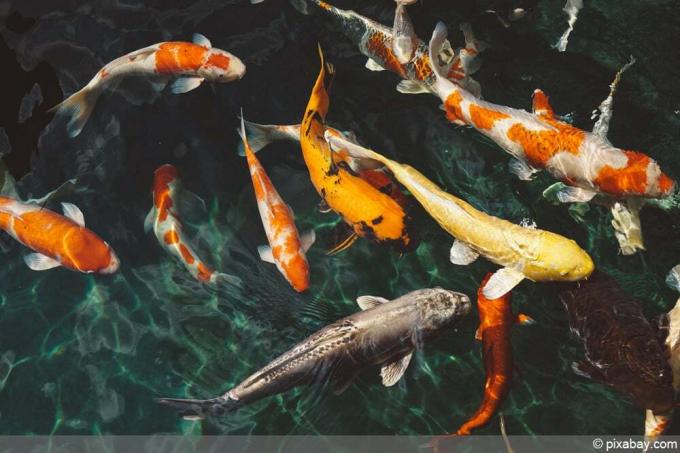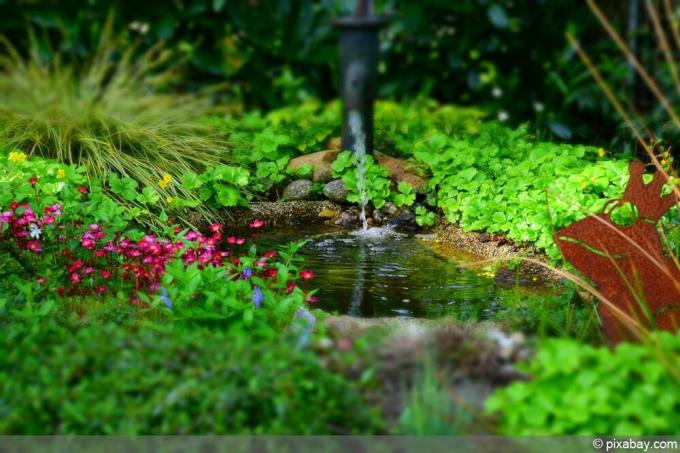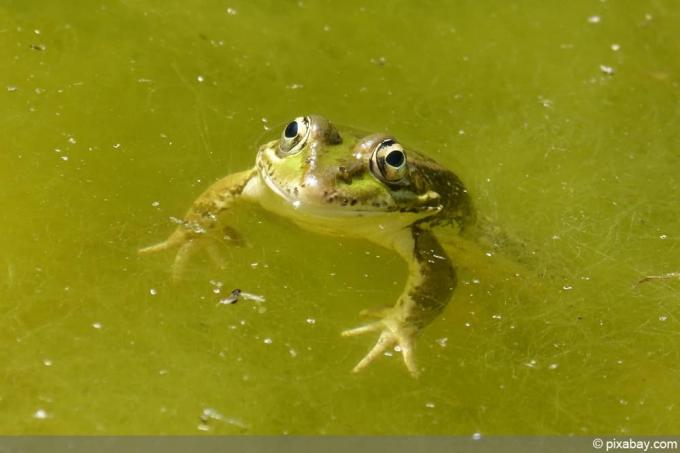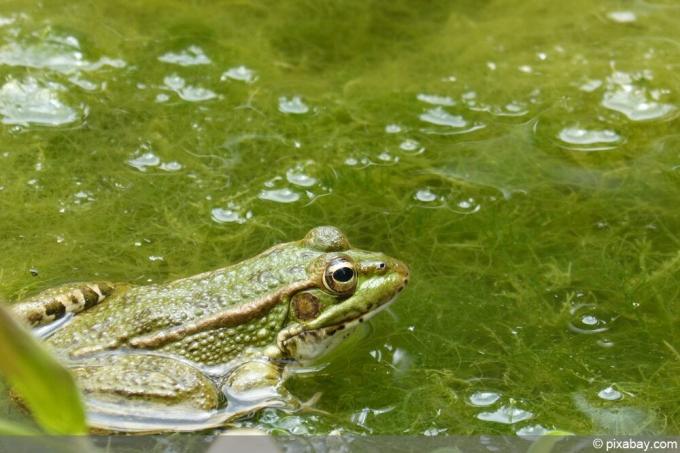

Table of contents
- What does carbonate hardness describe?
- Lower the carbonate hardness value in the pond
- Increase too low KH value
- Significance of carbonate hardness in pond water
- Measure water parameters regularly
Anyone who owns a garden pond should keep an eye on its most important water values, because the garden pond system can only function properly if they are in order. The water quality depends in particular on the carbonate hardness and the pH value, i.e. the degree of acidity of the water. Fluctuations in these values can be life-threatening for pond inhabitants. Consequently, the determination of the most important water parameters should be the main part of pond care.
What does carbonate hardness describe?
Ponds are among the most species-rich biotopes that provide habitat for numerous animals and plants. The carbonate hardness is an important variable for permanently good water quality. It describes the concentration of dissolved minerals, especially calcium and magnesium, and is an important value for the buffering capacity of the pond water. The main concern here is how well the body of water can absorb fluctuations in the pH value. It makes no difference whether it is a garden pond or a koi pond, because water behaves in the same way in both types of pond.
Ponds tend to become acidic after a certain period of time. The buffering effect of the carbonates can absorb these acids and thus counteract a drop in the pH value, a so-called acid drop. Excessive growth of algae can be subject to large fluctuations in pH from one day to the next, requiring measures to be taken to raise or lower it accordingly.
The carbonate hardness value (KH value) is given in º dH (German degree of hardness) and is ideally between 6º and 8º dH. The higher the value, the more stable the pH value of the water. In addition to the carbonate hardness, the total hardness of the minerals dissolved in the pond water is always decisive. Because if the overall hardness is too soft, the biological processes in the pond stagnate. Therefore, you should always measure both values and keep an eye on them.
Lower the carbonate hardness value in the pond

If many dissolved minerals get into the pond water, be it through various pond care products or rock containing minerals, the carbonate hardness value (KH value) in the water increases. However, countless microorganisms in the water absorb minerals, so that a too high KH value in pond water is rather rare. This value is too high if it is above 18º dH.
If the pH value is too high, the ammonium contained in the water can be converted into dangerous ammonia. To counteract this from the outset, you should not use too much water to fill a garden pond Use hard tap water, preferably well water or treated water rainwater. If it is actually necessary to lower the KH value, there are several options:
- Reduce carbonate hardness by softening the pond water
- To do this, add soft water to the pond
- Carry out a partial or complete water change
- Prolonged or frequent rainfall can compensate for high carbonate levels
- Reduction of the carbonate hardness leads to a simultaneous lowering of the pH value
- Softening, also possible through the use of strong UVC lamps
- UV light softens the water
- With UVC lamps, pay attention to low wattage to keep electricity costs low
- Use of these lamps is only recommended if a good filter system is available
Occasionally it is recommended to use peat as a water softener, but this is usually not advisable, because peat releases acids into the water, thereby lowering the pH value and thus only misleading an actual softening before. If you still want to try it, you should change the peat regularly.
Tip:
What you should never do is discharge untreated rainwater, for example from the gutter, into the pond. Bird droppings, algae, pollutants and much more would be washed into the pond, which in turn can seriously disturb the balance in the pond.
Increase too low KH value
If the carbonate hardness is exactly 5º dH or below, for example in newly created or stagnant bodies of water, appropriate measures must be taken to increase it as quickly as possible. If the degree of hardness is too low, this leads to fluctuations in the pH value and it becomes unstable. Persistent rainfall is often responsible for this.
Water changes that have not been carried out for a long time or be the complete renunciation of it. As a result, the degree of hardness decreases more and more over time. Carbonates cannot be added to the water without occasional water changes or the addition of special products. Carbonates can be added to the water in different ways.
- Increasing the carbonate hardness brings with it a simultaneous increase in the pH value
- The degree of increase should not exceed 1º dH per day if possible
- To harden the water z. B. Feed Shell Salute
- Also known from aquaristics and consists mainly of calcium carbonate (lime)
- Introduce seashells into an existing stream or multi-chamber filter
- Calcium carbonate slowly and continuously hardens the pond water
- Limestones in streams have a similar effect
- Smaller surface of the stones can harden water only slowly
- Specialist shops also offer suitable means for adjusting the carbonate and total hardness
- With a higher carbonate hardness value, the pH value can also stabilize again

If possible, no rainwater should be discharged into a pond with a low KH value. It is much too soft and would rather worsen the water parameters. This is particularly evident in very rainy years, in increased growth of algae. A KH value that is too low can trigger a veritable chain reaction, because if the pH value is too low, the nitrite content and thus the toxicity in the water increases. Therefore, it is better to discharge well or tap water if the carbonate hardness value is actually too low.
Tip:
A drastic drop in carbonate hardness can be counteracted with stabilizing water treatment agents from specialist shops or by changing the water.
Significance of carbonate hardness in pond water
As already mentioned, the carbonate hardness in the pond water is responsible for a stable pH value. Ideally, this should be between 7.5 and 8.5. The cleaner the water in the pond, the lower this value. But what does a carbonate hardness value that is too high or too low mean and when is it optimally set?
Less than 5ºdH
If this value is below 5ºdH, it is too low. This leads to fluctuations in the pH value, and the toxicity of nitrite and ammonium increases. This value should be raised to at least 5ºdH, which stabilizes the lime-carbonic acid balance.
Between 5 and 14ºdH
With values between 5 and 14ºdH, the degree of hardness of the pond water is optimal, with a value of around 10 being very good. The pH value is stable and the natural self-cleaning of the pond works, which also makes pond care much easier.
Greater than 14ºdH
A carbonate hardness of more than 14ºdH is too high, but this is rarely the case. If the value is too high, the pond technology usually also suffers, e.g. B. pond pumps. The degree of hardness can be reduced by introducing rainwater or well water.
Measure water parameters regularly

The life of plants and animals in the garden pond largely depends on the water quality. Garden ponds are usually not natural bodies of water and require appropriate care. The water values are determined by various factors, such as persistent rainfall, excessive rainfall Fish stock, too intensive or incorrect feeding, as well as incorrectly installed pond technology or water changes unsuitable water.
The water in the garden pond is subject to corresponding fluctuations over the course of a day. Due to plants, algae and natural photosynthesis, the pH value can be rather high in the evening and significantly lower again in the morning. The carbonate hardness decreases continuously due to strong growth of algae. This makes the pH unstable. For these reasons, a regular check of the water values or their stabilization, in particular the carbonate hardness and the total hardness, is essential for a stable environment in the pond.
In order to be able to determine the water values safely and reliably, the specialist trade offers appropriate water tests. There are special test strips or test strips for quick measurements of the water parameters in between. Quick tests that provide exact values within a few seconds. So-called droplet tests are also suitable for weekly measurements.
 garden editorial
garden editorial I write about everything that interests me in my garden.
Find out more about caring for a garden pond

Copper sulphate against algae | 5 tips for use & dosage
Copper sulphate is a proven remedy against algae infestation. However, dealing with it is not that easy, as it also damages or destroys plants and fish. can kill. For this reason and because of its environmental hazard, the use of products containing copper sulphate is being discussed.

pond is losing water | 4 reasons for water loss
A body of water in your own garden is an absolute eye-catcher. But what if the garden pond suddenly loses water? Is the pond leaking or is it because of the hot temperatures? How much evaporation is actually normal in summer?

Pond security: five ways of child security for garden ponds
A pond is a feast for the eyes in every garden. However, it can also become a deadly trap for children. A garden pond therefore absolutely needs a safeguard that reliably prevents children from falling in and drowning. Here you can find out what security measures are in place.

Green water in the garden pond - what to do against cloudy pond water?
Green water in the garden pond is annoying and can not only spoil the joy of the decorative body of water, but also become dangerous for its inhabitants. But what to do about cloudy pond water? We reveal it here.

Remove and dispose of pond sludge – but what to do with it?
Removing pond sludge is important to maintaining water quality and preventing the formation of putrefactive sludge. But what is the best way to remove and dispose of it? Here are the right instructions.
Build a pond heater yourself - instructions
A pond heater ensures that the water in the pond is always at the desired temperature. Of course, this is good for all living things in winter, especially in winter. Some game fish, which are often kept as ornaments, require higher temperatures than our “ordinary” pond fish. In smaller ponds, which like to freeze through in winter, the fish can remain in the pond and do not have to be caught out and overwintered frost-free.



